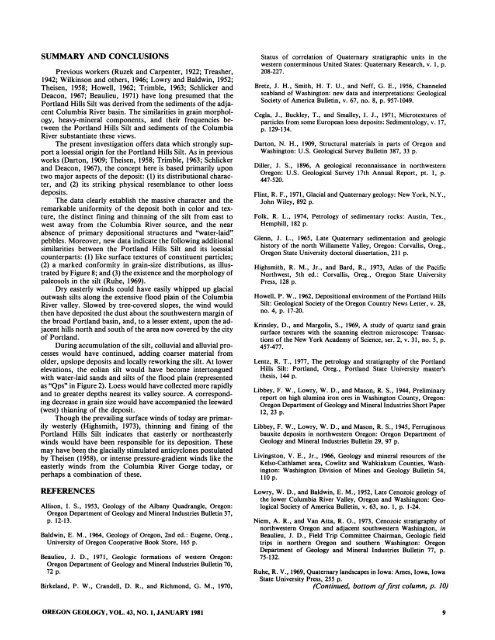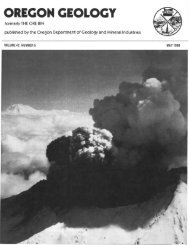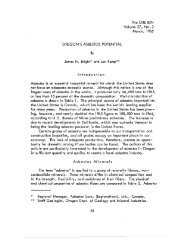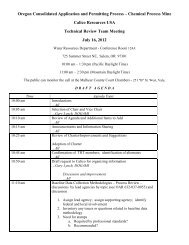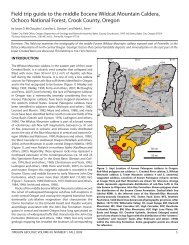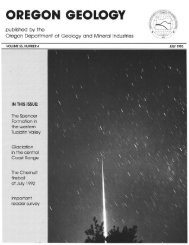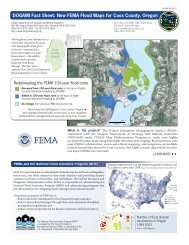The petrology and stratigraphy of the Portland Hills Silt - Oregon ...
The petrology and stratigraphy of the Portland Hills Silt - Oregon ...
The petrology and stratigraphy of the Portland Hills Silt - Oregon ...
You also want an ePaper? Increase the reach of your titles
YUMPU automatically turns print PDFs into web optimized ePapers that Google loves.
SUMMARY AND CONCLUSIONS<br />
Previous workers (Ruzek <strong>and</strong> Carpenter, 1922; Treasher,<br />
1942; Wilkinson <strong>and</strong> o<strong>the</strong>rs, 1946; Lowry <strong>and</strong> Baldwin, 1952;<br />
<strong>The</strong>isen, 1958; Howell, 1962; Trimble, 1963; Schlicker <strong>and</strong><br />
Deacon, 1967; Beaulieu, 1971) have long presumed that <strong>the</strong><br />
Portl<strong>and</strong> <strong>Hills</strong> <strong>Silt</strong> was derived from <strong>the</strong> sediments <strong>of</strong> <strong>the</strong> adjacent<br />
Columbia River basin. <strong>The</strong> similarities in grain morphology,<br />
heavy-mineral components, <strong>and</strong> <strong>the</strong>ir frequencies between<br />
<strong>the</strong> Portl<strong>and</strong> <strong>Hills</strong> <strong>Silt</strong> <strong>and</strong> sediments <strong>of</strong> <strong>the</strong> Columbia<br />
River substantiate <strong>the</strong>se views.<br />
<strong>The</strong> present investigation <strong>of</strong>fers data which strongly support<br />
a loessial origin for <strong>the</strong> Portl<strong>and</strong> <strong>Hills</strong> <strong>Silt</strong>. As in previous<br />
works (Darton, 1909; <strong>The</strong>isen, 1958; Trimble, 1963; Schlicker<br />
<strong>and</strong> Deacon, 1967), <strong>the</strong> concept here is based primarily upon<br />
two major aspects <strong>of</strong> <strong>the</strong> deposit: (1) its distributional character,<br />
<strong>and</strong> (2) its striking physical resemblance to o<strong>the</strong>r loess<br />
deposits.<br />
<strong>The</strong> data clearly establish <strong>the</strong> massive character <strong>and</strong> <strong>the</strong><br />
remarkable uniformity <strong>of</strong> <strong>the</strong> deposit both in color <strong>and</strong> texture,<br />
<strong>the</strong> distinct fining <strong>and</strong> thinning <strong>of</strong> <strong>the</strong> silt from east to<br />
west away from <strong>the</strong> Columbia River source, <strong>and</strong> <strong>the</strong> near<br />
absence <strong>of</strong> primary depositional structures <strong>and</strong> "water-laid"<br />
pebbles. Moreover, new data indicate <strong>the</strong> following additional<br />
similarities between <strong>the</strong> Portl<strong>and</strong> <strong>Hills</strong> <strong>Silt</strong> <strong>and</strong> its loessial<br />
counterparts: (1) like surface textures <strong>of</strong> constituent particles;<br />
(2) a marked conformity in grain-size distributions, as illustrated<br />
by Figure 8; <strong>and</strong> (3) <strong>the</strong> existence <strong>and</strong> <strong>the</strong> morphology <strong>of</strong><br />
paleosols in <strong>the</strong> silt (Ruhe, 1969).<br />
Dry easterly winds could have easily whipped up glacial<br />
outwash silts along <strong>the</strong> extensive flood plain <strong>of</strong> <strong>the</strong> Columbia<br />
River valley. Slowed by tree-covered slopes, <strong>the</strong> wind would<br />
<strong>the</strong>n have deposited <strong>the</strong> dust about <strong>the</strong> southwestern margin <strong>of</strong><br />
<strong>the</strong> broad Portl<strong>and</strong> basin, <strong>and</strong>, to a lesser extent, upon <strong>the</strong> adjacent<br />
hills north <strong>and</strong> south <strong>of</strong> <strong>the</strong> area now covered by <strong>the</strong> city<br />
<strong>of</strong> Portl<strong>and</strong>.<br />
During accumulation <strong>of</strong> <strong>the</strong> silt, colluvial <strong>and</strong> alluvial processes<br />
would have continued, adding coarser material from<br />
older, upslope deposits <strong>and</strong> locally reworking <strong>the</strong> silt. At lower<br />
elevations, <strong>the</strong> eolian silt would have become intertongued<br />
with water-laid s<strong>and</strong>s <strong>and</strong> silts <strong>of</strong> <strong>the</strong> flood plain (represented<br />
as "Qps" in Figure 2). Loess would have collected more rapidly<br />
<strong>and</strong> to greater depths nearest its valley source. A corresponding<br />
decrease in grain size would have accompanied <strong>the</strong> leeward<br />
(west) thinning <strong>of</strong> <strong>the</strong> deposit.<br />
Though <strong>the</strong> prevailing surface winds <strong>of</strong> today are primarily<br />
westerly (Highsmith, 1973), thinning <strong>and</strong> fining <strong>of</strong> <strong>the</strong><br />
Portl<strong>and</strong> <strong>Hills</strong> <strong>Silt</strong> indicates that easterly or nor<strong>the</strong>asterly<br />
winds would have been responsible for its deposition. <strong>The</strong>se<br />
may have been <strong>the</strong> glacially stimulated anticyclones postulated<br />
by <strong>The</strong>isen (1958), or intense pressure-gradient winds like <strong>the</strong><br />
easterly winds from <strong>the</strong> Columbia River Gorge today, or<br />
perhaps a combination <strong>of</strong> <strong>the</strong>se.<br />
REFERENCES<br />
Allison, I. S., 1953, Geology <strong>of</strong> <strong>the</strong> Albany Quadrangle, <strong>Oregon</strong>:<br />
<strong>Oregon</strong> Department <strong>of</strong> Geology <strong>and</strong> Mineral Industries Bulletin 37,<br />
p. 12-13.<br />
Baldwin, E. M., 1964, Geology <strong>of</strong> <strong>Oregon</strong>, 2nd ed.: Eugene, Oreg.,<br />
University <strong>of</strong> <strong>Oregon</strong> Cooperative Book Store, 165 p.<br />
Beaulieu, J. D., 1971, Geologic formations <strong>of</strong> western <strong>Oregon</strong>:<br />
<strong>Oregon</strong> Department <strong>of</strong> Geology <strong>and</strong> Mineral Industries Bulletin 70,<br />
72 p.<br />
Birkel<strong>and</strong>, P. W., Cr<strong>and</strong>ell, D. R., <strong>and</strong> Richmond, G. M., 1970,<br />
Status <strong>of</strong> correlation <strong>of</strong> Quaternary stratigraphic units in <strong>the</strong><br />
western conterminous United States: Quaternary Research, v. I, p.<br />
208-227.<br />
Bretz, J. H., Smith, H. T. U., <strong>and</strong> Neff, G. E., 1956, Channeled<br />
scabl<strong>and</strong> <strong>of</strong> Washington: new data <strong>and</strong> interpretations: Geological<br />
Society <strong>of</strong> America Bulletin, v. 67, no. 8, p. 957-1049.<br />
Cegla, J., Buckley, T., <strong>and</strong> Smalley, I. J., 1971, Microtextures <strong>of</strong><br />
particles from some European loess deposits: Sedimentology, v. 17,<br />
p. 129-134.<br />
Darton, N. H., 1909, Structural materials in parts <strong>of</strong> <strong>Oregon</strong> <strong>and</strong><br />
Washington: U.S. Geological Survey Bulletin 387, 33 p.<br />
Diller, J. S., 1896, A geological reconnaissance in northwestern<br />
<strong>Oregon</strong>: U.S. Geological Survey 17th Annual Report, pt. I, p.<br />
447-520.<br />
Flint, R. F., 1971, Glacial <strong>and</strong> Quaternary geology: New York, N.Y.,<br />
John Wiley, 892 p.<br />
Folk, R. L., 1974, Petrology <strong>of</strong> sedimentary rocks: Austin, Tex.,<br />
Hemphill, 182 p.<br />
Glenn, J. L., 1965, Late Quaternary sedimentation <strong>and</strong> geologic<br />
history <strong>of</strong> <strong>the</strong> north Willamette Valley, <strong>Oregon</strong>: Corvallis, Oreg.,<br />
<strong>Oregon</strong> State University doctoral dissertation, 231 p.<br />
Highsmith, R. M., Jr., <strong>and</strong> Bard, R., 1973, Atlas <strong>of</strong> <strong>the</strong> Pacific<br />
Northwest, 5th ed.: Corvallis, Oreg., <strong>Oregon</strong> State University<br />
Press, 128 p.<br />
Howell, P. W., 1962, Depositional environment <strong>of</strong> <strong>the</strong> Portl<strong>and</strong> <strong>Hills</strong><br />
<strong>Silt</strong>: Geological Society <strong>of</strong> <strong>the</strong> <strong>Oregon</strong> Country News Letter, v. 28,<br />
no. 4, p. 17-20.<br />
Krinsley, D., <strong>and</strong> Margolis, S., 1969, A study <strong>of</strong> quartz s<strong>and</strong> grain<br />
surface textures with <strong>the</strong> scanning electron microscope: Transactions<br />
<strong>of</strong> <strong>the</strong> New York Academy <strong>of</strong> Science, ser. 2, v. 31, no. 5, p.<br />
457-477.<br />
Lentz, R. T., 1977, <strong>The</strong> <strong>petrology</strong> <strong>and</strong> <strong>stratigraphy</strong> <strong>of</strong> <strong>the</strong> Portl<strong>and</strong><br />
<strong>Hills</strong> <strong>Silt</strong>: Portl<strong>and</strong>, Oreg., Portl<strong>and</strong> State University master's<br />
<strong>the</strong>sis, 144 p.<br />
Libbey, F. W., Lowry, W. D., <strong>and</strong> Mason, R. S., 1944, Preliminary<br />
report on high alumina iron ores in Washington County, <strong>Oregon</strong>:<br />
<strong>Oregon</strong> Department <strong>of</strong> Geology <strong>and</strong> Mineral Industries Short Paper<br />
12, 23 p.<br />
Libbey, F. W., Lowry, W. D., <strong>and</strong> Mason, R. S., 1945, Ferruginous<br />
bauxite deposits in northwestern <strong>Oregon</strong>: <strong>Oregon</strong> Department <strong>of</strong><br />
Geology <strong>and</strong> Mineral Industries Bulletin 29, 97 p.<br />
Livingston, V. E., Jr., 1966, Geology <strong>and</strong> mineral resources <strong>of</strong> <strong>the</strong><br />
Kelso-Cathlamet area, Cowlitz <strong>and</strong> Wahkiakum Counties, Washington:<br />
Washington Division <strong>of</strong> Mines <strong>and</strong> Geology Bulletin 54,<br />
110 p.<br />
Lowry, W. D., <strong>and</strong> Baldwin, E. M., 1952, Late Cenozoic geology <strong>of</strong><br />
<strong>the</strong> lower Columbia River Valley, <strong>Oregon</strong> <strong>and</strong> Washington: Geological<br />
Society <strong>of</strong> America Bulletin, v. 63, no. I, p. 1-24.<br />
Niem, A. R., <strong>and</strong> Van Atta, R. 0., 1973, Cenozoic <strong>stratigraphy</strong> <strong>of</strong><br />
northwestern <strong>Oregon</strong> <strong>and</strong> adjacent southwestern Washington, in<br />
Beaulieu, J. D., Field Trip Committee Chairman, Geologic field<br />
trips in nor<strong>the</strong>rn <strong>Oregon</strong> <strong>and</strong> sou<strong>the</strong>rn Washington: <strong>Oregon</strong><br />
Department <strong>of</strong> Geology <strong>and</strong> Mineral Industries Bulletin 77, p.<br />
75-132.<br />
Ruhe, R. V., 1969, Quaternary l<strong>and</strong>scapes in Iowa: Ames, Iowa, Iowa<br />
State University Press, 255 p.<br />
(Continued, bottom <strong>of</strong> first column, p. 10)<br />
OREGON GEOLOGY, VOL. 43, NO. I, JANUARY 1981<br />
9


